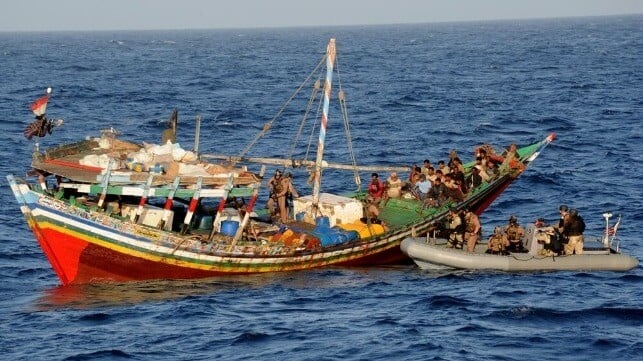Somali Dhows Serve All Sides and Pose an Interception Challenge
While it might be labeled by Western observers as a smuggling operation, the traffic is better characterized as an anarchic free market enterprise

Recent reports suggest that the Houthis are now trying to establish their own version of the Axis of Resistance by forming links with insurrectionist groups across the Gulf of Aden into Somalia. Such reports may be crediting the warring parties in this region with political and military ambitions which outstrip their organizational capability.
A more sober interpretation of recent events is that outside actors are seeking opportunistic advantage in an unstable political landscape where alliances and loyalties are constantly changing. Factions within Somalia are more interested in fending off each other to gain local advantage, rather than taking on external enemies, and piracy is likely to remain the greatest threat coming out of Somalia.
It has been a long time since Somalia could be considered to be a single united country - if it ever was. Created in 1960 by the merger on independence of the two separate Italian and British colonies, each with very different administrative traditions, the country from the outset was riven by the competing ambitions of rival clans, and also unsettled by popular demands that Somalia should also encompass Djibouti, the Northern Frontier District of Kenya and the Ogaden region of Ethiopia.
After a military coup in 1969, there was a period of stability under Siad Barre, before a war with Ethiopia and internal rebellions led to a collapse of the unified state. This led to the effective partition of Somalia into Somaliland, Puntland, Galmudug, an area controlled by the rump federal government, and Mogadishu (controlled by the Islamic Courts Union).
In practice, what was a single country now functions with a patchwork of local autonomous administrations operating in the North of the country, with the internationally-recognized Federal Government running the south (while battling Al Shabaab insurgents). Each area tends to have a revolving cast of foreign backers.
Within all these areas, local security remains the primary preoccupation. Boundaries, control, clan and tribal allegiances are often in a state of flux, and communities must be defended. Hence there is a high demand for weaponry, and outside support and assistance is often called upon to gain advantage in local competitions where political control is disputed. Both “good guys” and “bad guys” need these weapons.
This demand for weaponry is met primarily by traders using traditional dhows - which also carry a big share of Somalia’s imports -from the Gulf and beyond and up the East African coast (notwithstanding the container terminals at Berbera and Bosaso). These dhows are often stateless. While it might be labeled by Western observers as a smuggling operation, the traffic is better characterized as an anarchic free market enterprise in an area where there is little central government oversight. The same trade also services Yemen, and it also carries some of the flow of economic refugees from East Africa through Somalia and Yemen into Saudi Arabia and the Gulf states.
It should be expected that the IRGC Qods Force, the Houthis, Al Shabaab and Al Qaeda in the Arabian Peninsula (AQAP) all piggy-back on this well-established trader network, with the traders usually providing services on arms-length commercial terms rather than because of political sympathies.
US Africa Command - which conducted an airstrike on a stateless dhow and a smaller support boat on April 16 - had received information from the Somali Federal Government that the vessels were transshipping ‘advanced conventional weapons’ destined for Al Shabaab. However, in this arena, alliances change and foes become friends overnight. For this reason, the CENTCOM Fifth Fleet interdiction at sea policy - which enables the source and destination of weapons cargoes to be discovered post-seizure - is probably the template approach to conducting intercepts. But in the meantime, it might be wise for trader dhows to stop carrying arms.
The opinions expressed herein are the author's and not necessarily those of The Maritime Executive.
